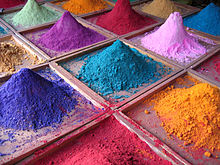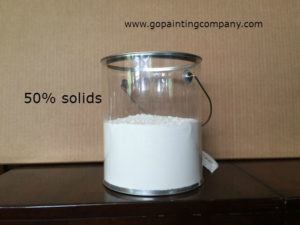Quality Paint 101
There are several factors to take into consideration when choosing a paint. While price is always important, the quality of the paint is critical. Most people get confused and assume that the more expensive the paint the better it is. While this may often be the case, understanding what makes one paint better then another simplifies the selection process. I have often found coatings that were far superior to more expensive choices by knowing what to look for. The superlatives like Ultra, Super, Premium… mean nothing. These are marketing terms only.
There is a vast number of components in paint but all paint is basically made up of 3 key ingredients. The solvent or thinner, the binder and the pigment.
Pigments or the tint is what gives paint its color. It also imparts the hide. Pigments are pure color and tints are pigment dispersed in surfactants and a liquid. Often the liquid is glycol.

pigments at a market in India
Pigment
A quality paint will have a significant percentage of the pigment titanium dioxide along with smaller amounts of other pigments or tint to provide color. Titanium dioxide provides good hide and is considered a more expensive component of paint.
Cheaper substitutes for titanium dioxide are talc, calcium carbonate, clay and silica. These ingredients have poor durability and are much less expensive.
Solvent
The solvent is the liquid that everything is suspended into. It combines the pigment with the binders. The solvent is critical for consistency, cure time and uniformity of color. Many paints today are Latex or water based paints so the solvent is water. There are of course oil base paints where the solvent is mineral spirits. Often a quick way to determine the solvent is look at the label and see what is suggested for clean-up. That is usually the solvent. If the label says to clean-up with Xylene, then Xylene is the solvent. If it says to clean-up with water, then water is the solvent.
Binder
The binder holds the pigments and other solids together once the solvent has evaporated and everything has dried. The binders play a critical role in determining durability of the paint and the adhesion to the underlying surface. When choosing a latex product, look for a 100% Acrylic latex binder.
No More Guesswork
A quality paint contains the best binders, pigments and solvents and these ingredients are more refined. The paint will also contain more of these solids by volume then a lessor quality product. This is a key difference. Knowing the percentage of solids in a gallon of paint (by volume) is a quick reference to performance and the grade of a paint. The solids are what is left behind after the paint has dried. If a can of paint has 50% solids, 50% of what is in that can will actually end up on what you are painting when the paint has dried. A paint with 25% solids has less “good stuff ” in the can. Now we are assuming it is “good stuff ” because one way paint manufactures jack up the percent solids is by adding ingredients that don’t help with performance. They are essentially just fillers like clay.

Two quick tests you can do are as follows. Pick up two cans of paint. Does one feel significantly heavier then the other. Remember they are both gallons of paint. The heavier of the two has higher solids. Another quick test is to actually get your fingers in the paint. Rubbing a little of the paint between your fingers will quickly tell you how refined the ingredients are. Does it feel gritty or smooth? Higher grade ingredients can be milled much finer then cheaper products. You want a silky smooth product.
A data sheet should always be available where you buy your paint. It will have important information about the percent solids and what those solids are. Any good paint store will have data sheets available for you. In the box stores it may be more of a challenge to get this information.
Color selection is an individual choice and usually not a factor in the grade of a paint. However, a high end product can have its performance diminished dramatically by over tinting. Paints are available in different bases and each base can take different amounts of tint. The bases available vary from each manufacturer but are usually white, midtone, deeptone, ultra deep, neutral tint and accent base.
The maximum amount of tint that is added to each base is a factor of the final color. White and tint bases usually can take about 4 oz of colorant, deep base about 8 oz, ultra deep about 10 oz, and accent bases about 14 oz. Using the wrong base or over tinting any base will cause problems. When large amounts of tint are used, factors such as curing time, hide, water and abrasion resistance and color uniformity are affected negatively.
The weakness comes from the increased amount of surfactants and glycol that the pigments are suspended into to make the tint. The surfactants stay in the paint film longer and affect dry time, hide and durability of the paint. If you are painting with a over tinted product you will notice it is taking multiple coats to hide what it is going over and you will notice it taking much longer for the paint to dry. We painted a door black years ago only to discover the paint that my supplier gave me was way over tinted. They did not have a “factory” black in stock or the correct base to make a black paint and subsequently gave me a a product that had so much black tint in it that days later it was still “wet”. You could press your finger print into the paint film a week later.
Mistakes are made but not common. Trust that your supplier will give you the right base and tint accordingly. As a rule I stay away from neutral tint bases whenever possible. They generally have such poor hide that multiple coats are required. Try to get an accent base instead. Much more money but worth it see Quality Paint blog post.
As a general rule a brands various paint sheens perform the same. It should be noted that there are no standards for paint sheen. One brands idea of an eggshell sheen may be another manufacturers flat. Paint sheen cannot be adjusted at the store. There isn’t something they can add or subtract to change the sheen. A contractor can however make some adjustments in the field by mixing a flat with a satin, etc. Any paint store can match another paint stores colors but they cannot match the other guys sheen. Sheens available are usually flat, eggshell, satin, semi-gloss and gloss. As a general rule the flatter a paint the better it hides imperfections on what it is applied to (like a wall) but it will be subject to less stain resistance. As you increase the sheen of the paint imperfections are highlighted but stain resistance and cleanability increase.
Warranty claims from paint manufactures are pure marketing but can be used as a guide to quality.



